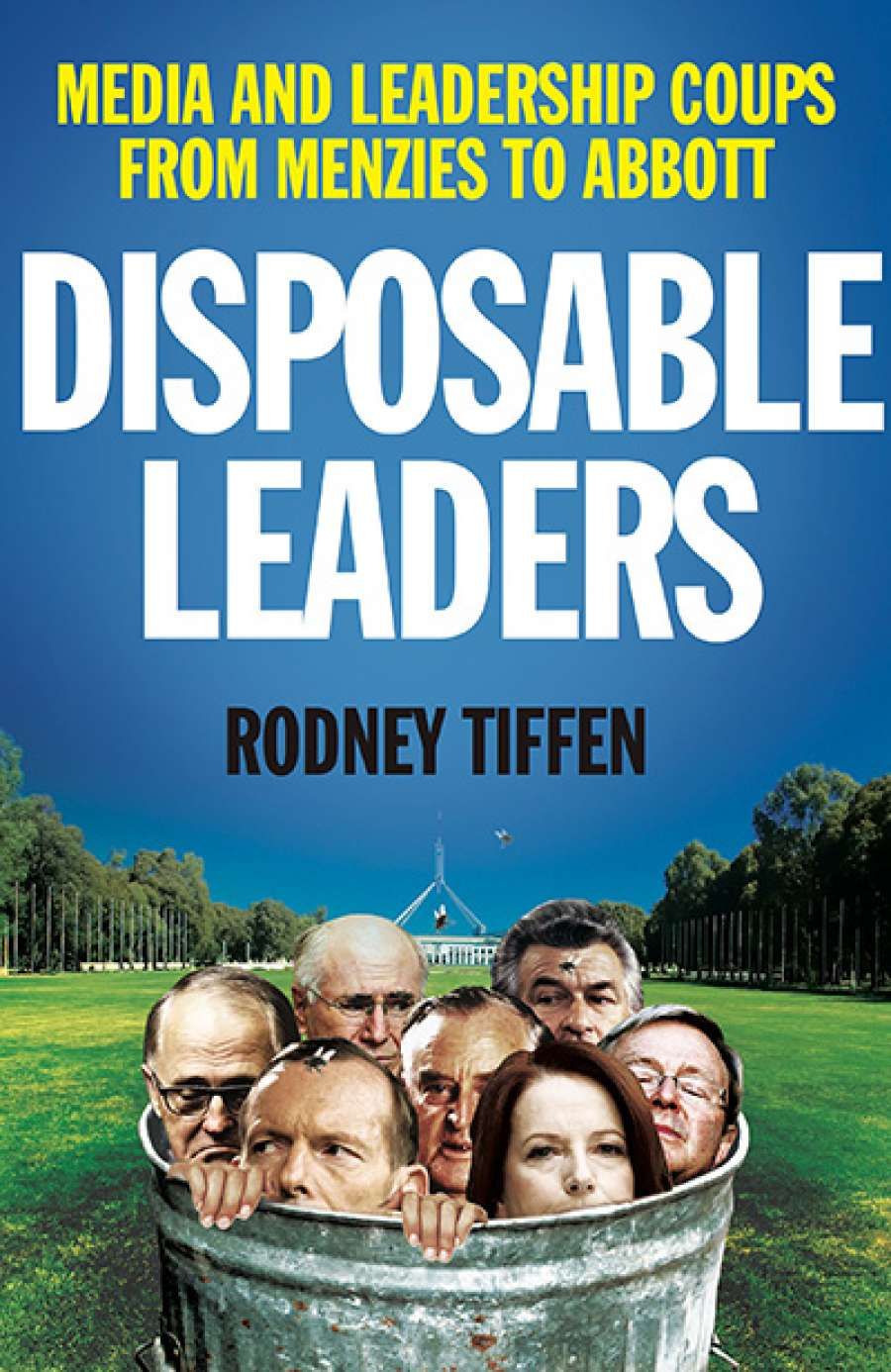
- Free Article: No
- Contents Category: Politics
- Custom Article Title: Dennis Altman reviews 'Disposable Leaders: Media and leadership coups from Menzies to Abbott' by Rodney Tiffen
- Book 1 Title: Disposable Leaders
- Book 1 Subtitle: Media and leadership coups from Menzies to Abbott
- Book 1 Biblio: NewSouth $34.99 pb, 308 pp, 9781742235202
Rodney Tiffen draws on the last fifty years of political intrigue to ask why Australia has seen a growing tendency for leadership coups and to examine, at both state and federal levels, the role of the media in such conflicts. He claims that ‘no other parliamentary democracy has had anything resembling Australia’s leadership instability’, a big claim, and one for which he gives no hard evidence. Certainly, he demonstrates that the turnover of parliamentary leaders is accelerating, counting seventy-three successful leadership challenges in the major parties since 1970. But he also struggles to account for the turnover. Nor does he demonstrate that changes in the media have been particularly important in explaining these turnovers.
Disposable Leaders gives us an enjoyable romp through fifty years of political chicanery, going back to Gough Whitlam’s crack about Billy McMahon as ‘Tiberius with a telephone’. Tiffen is assiduous in chronicling many of the intra-party coups and cabals, from the post-Holt Liberal governments of John Gorton and McMahon to the recent roundabouts in leadership since Howard. His account of leadership battles at the state level is fascinating political history, even if at times one wants more, as when Joan Kirner was brought in to save a declining Labor government in Victoria in 1990. (There is surely a book to be written on the growing custom of promoting women to leadership at times when governments seem to be floundering.) Political junkies will take issue with some of his accounts, but this is a valuable, if uneven, compendium.
The major coups canvassed, involving all our prime ministers since Hawke (1983–91), have already been widely dissected, and Tiffen relies largely on second-hand material to revisit already familiar territory. Inevitably, he misses some of the relevant material; there is no reference to Norman Abjorensen’s The Manner of their Going (2015), nor to memoirs by Peter Garrett and Bob Brown. But he retells these stories with some aplomb, and the first half of the book is enjoyable reading. That said, there is an unevenness to the structuring of Disposable Leaders that leaves too many loose threads. One example: a subheading in the chapter on ‘iatrogenic spin doctoring’ is ‘The West Wing Delusion’. But we are not told what this delusion was, only that Tiffen lost interest in the program.
Tiffen’s account of the media stems almost entirely from a period when print newspapers and free-to-air television were supreme. He writes as if the domination of the press gallery remains unchallenged; indeed, he reminds us of the role played by reporter Alan Reid in unseating Gorton. The most cited journalists are veterans Paul Kelly, Michele Grattan, and Peter Hartcher. Electronic media is strangely missing from the analysis, even though it is surely central to understanding the changing nature of politics and media. Tiffen suggests that the line between commentary and reporting has become increasingly blurred, and, rightly, points to the consistent abuse of air time by shock-jocks, including Alan Jones and Andrew Bolt. What is absent is any discussion of the new world of online publications, blogs, posts, and tweets. There are references to the role of programs such as Four Corners and The Chaser, including their pranks during the 2007 APEC summit, when Howard was almost deposed by his cabinet colleagues, but no mention of the ways in which YouTube and other online video platforms have affected the immediacy of political life.
 Julia Gillard and Kevin Rudd at their first press conference as leader and deputy leader of the Australian Labor Party on 4 December 2006 (photograph by Adama Carr, Wikimedia Commons)
Julia Gillard and Kevin Rudd at their first press conference as leader and deputy leader of the Australian Labor Party on 4 December 2006 (photograph by Adama Carr, Wikimedia Commons)
Tiberius’s telephone is now a smart device, and political leaders have full-time staffers employed to engage with the virtual world. Tiffen claims that there have been qualitative changes in the media landscape, but his examples are often drawn from earlier periods. Thus he rounds up his comments about spin doctors with a quote from Richard Nixon: apposite but hardly suggesting much has changed in four decades.
In Disposable Leaders, Tiffen makes a convincing case that political parties, and particularly their parliamentary wings, have become increasingly impatient with apparent failures of leadership, and too willing to dispose of unpopular leaders. He fails to explain either their frequency or to fully explore the changing role of the media in intra-party struggles for power. But the cover image, of seven heads caught in a tumbril bucket, is a powerful reminder of the perils of short-term decision making.


Comments powered by CComment